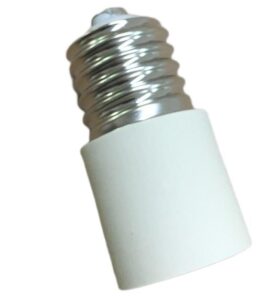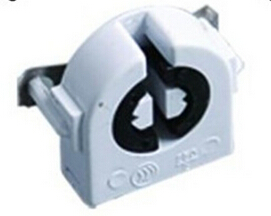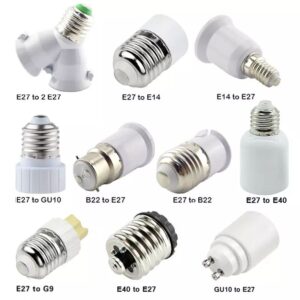When it comes to lighting, it’s important to know the difference between a lamp and a socket. This will help you pick the right stuff, fix things, or upgrade your home lighting. A lot of people use these terms interchangeably, but they’re different parts of the lighting system. If you mix them up, you might buy the wrong stuff or put something in the wrong place, which could mess up your lighting, make it unsafe, or look bad.
A lamp is the whole light fixture, including the shade, the bulb, and the base. The socket is the part of the light fixture that holds the bulb and connects it to the electrical circuit.
In this guide, we’re going to talk about the differences between a lamp and a socket, what they do, and how they work together to give you safe and effective lighting.

What Is a Lamp?
A lamp is the complete lighting fixture that provides illumination. It includes several parts, all of which contribute to the functionality and design of the light. Here are the main components of a lamp:
- The Bulb: This is the source of light within the lamp. Bulbs can vary depending on the type of light needed—common types include incandescent, LED, and CFL bulbs. The bulb provides the actual light and determines the brightness and color temperature.
- The Lampshade or Cover: Most lamps have a shade or cover that serves two purposes. First, it diffuses the light to create a softer glow, preventing glare. Second, it adds an element of design, helping to complement the room’s decor. Shades come in various materials such as fabric, glass, or metal, and can dramatically affect the overall lighting effect in the room.
- The Base or Stand: The base of the lamp provides stability and structure. Depending on the type of lamp, the base could be a simple stand for a table lamp, a tall post for a floor lamp, or the ceiling mount for a pendant lamp or chandelier. The base is often a major element in the design of the lamp and is made from materials like metal, wood, or ceramic.
- Power Switch or Controls: Every lamp has a method for turning it on and off. In some cases, this may be a simple on/off switch, while in others it could be a dimmer that allows you to adjust the brightness. Many modern lamps come with smart controls that can be operated via an app or voice assistants like Alexa or Google Assistant.
A lamp is more than just a functional item—it is also a decorative element that enhances the style of a space. Lamps come in countless designs, ranging from minimalistic and modern to ornate and classic. Whether it’s a floor lamp in your living room or a pendant light hanging over your dining table, the lamp is a complete fixture that integrates form and function.

What Is a Socket?
The socket is one of the components inside a lamp that holds the light bulb and connects it to the electrical circuit. It may be a small part of the overall fixture, but it plays a critical role in ensuring the lamp functions correctly. The socket does the following:
- Provides Electrical Contact: The socket’s main purpose is to allow the bulb to receive electricity from the power source. It connects the lamp’s internal wiring to the bulb, allowing electricity to flow and the light to turn on. Without a working socket, the bulb will not light up, even if the rest of the lamp is functional.
- Holds the Bulb Securely: A socket provides a physical connection to hold the bulb in place. Depending on the type of bulb, the socket will have either a screw base (for Edison-style bulbs) or pins (for specialty bulbs such as GU10 or G9). The socket ensures that the bulb stays firmly connected to the electrical system.
- Types of Sockets: There are various types of lamp sockets designed to fit different types of bulbs. For example, Edison screw sockets like E26 or E27 are standard for most household bulbs. Pin-based sockets like GU10 or G9 are used for specific halogen or LED bulbs. Each socket is designed to hold a particular type of bulb securely and provide the right electrical connection.
While the socket is a critical part of the lamp, it is not the entire fixture. It serves as the technical component that ensures the electrical functionality of the bulb, making it essential to the overall operation of the lamp.

Functions of a Lamp vs. a Socket
The lamp and the socket serve different, yet complementary, functions in a lighting system. Understanding their roles will help you select and maintain lighting fixtures more effectively.
- Lamp Function: The primary function of the lamp is to provide light and contribute to the ambiance of a room. The lamp, as a whole fixture, includes the bulb, the shade or cover to soften the light, and the base or stand to give it structure. Lamps are designed with aesthetics in mind, as they are often focal points in interior design. The design, color, and material of the lamp all play a role in how it complements the room’s decor.
- Socket Function: In contrast, the socket is more technical. Its function is to connect the light bulb to the electrical circuit and ensure the safe and reliable flow of electricity to power the bulb. While the socket may not add much to the design of the lamp, it is crucial for the lamp’s performance. A faulty socket can lead to flickering lights, poor contact with the bulb, or even electrical hazards.

Materials and Design
The materials and design of a lamp versus a socket also highlight their different purposes.
- Lamps: Lamps are typically made from materials chosen for both their aesthetic appeal and durability. These materials can range from glass, ceramic, and fabric for the shade, to metals like brass or stainless steel for the base. The design of the lamp is a major consideration, as it is often a decorative piece in a room. Lamps can be designed in a wide variety of styles to match traditional, modern, or eclectic interiors.
- Sockets: Sockets, on the other hand, are typically made from heat-resistant materials like ceramic, plastic, or metal. These materials are selected primarily for safety and performance, rather than aesthetics. Sockets must withstand the heat generated by the bulb and provide a durable connection for years of use. Ceramic sockets, for example, are often used in high-heat environments because they are more heat-resistant than plastic.
The design focus for a lamp is on visual appeal and practicality, whereas the design of a socket focuses on safety, electrical connectivity, and heat management.

Common Mistakes: Confusing Lamps with Sockets
A common mistake many people make is confusing the lamp with the socket, especially when troubleshooting or replacing parts. For example, if a light bulb flickers or doesn’t turn on, many people assume the entire lamp is faulty when the issue could be just the socket. Similarly, when shopping for parts, it’s important to know whether you need to replace the socket itself or the entire lamp.
Here are some common scenarios where people might confuse the two:
- Replacing a Part: If your lamp stops working, make sure to diagnose whether the issue lies with the bulb, the socket, or the wiring before replacing the entire lamp. Often, it’s just the socket that needs replacing.
- Upgrading Lighting: When upgrading lighting, some people purchase new sockets thinking it will improve the overall lighting quality. In reality, the entire lamp may need to be upgraded to achieve the desired effect.
Being clear on the distinction between a lamp and a socket can save you time and money when troubleshooting lighting issues or making upgrades.

How Lamps and Sockets Work Together
Lamps and sockets are part of an interconnected system that works together to provide light. The lamp provides the physical structure and design that holds the bulb in place and controls the light’s direction and intensity. The socket, on the other hand, ensures the electrical connection between the bulb and the power source. Together, they form a complete lighting system.
Understanding how these components interact can help you maintain your lighting system and make informed decisions when selecting bulbs, replacing parts, or upgrading fixtures. If your lamp stops working, understanding that the socket is a critical part of the lamp’s operation can help you troubleshoot and potentially solve the issue by replacing just the socket, rather than the entire lamp.

Final Words
You need to know the difference between a lamp and a socket if you’re dealing with lighting. A lamp is the whole fixture, which includes the bulb, the shade, the base, and the controls. The light socket is the part inside the fixture that holds the bulb and connects it to the electrical circuit. Knowing the difference between the two will help you figure out what’s wrong, fix things, and pick the right stuff when you need to get new lighting components.
If you need to replace a socket, upgrade a lamp, or understand how your lighting system works, knowing the difference between these two things will help you make the right decisions.













